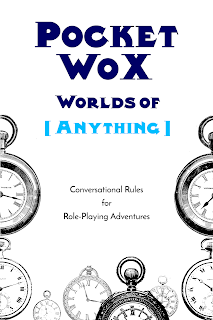In full PbtA games nearly all character actions and resources are expressed as Moves, little distinct resolution packets that broadly define an action and its potential outcomes. A typical Move is structured more or less like this:
In situation X, roll the dice and add Attribute Y to see if Z1, Z2 or Z3 happens.
In contrast, WoX doesn't use Moves. Instead, for broad actions that any character can attempt it uses simplified general-purpose attribute rolls, results interpreted on the spot based on context. Unique PC resources are expressed by Abilities, which are structured tersely:
Your character can do Z.
As I thought about it, that seemed too broad. Without the "in situation X" limit, there's really nothing to urge a player to consider if an ability is appropriate or not. Some implementations account for this by saying "you can attempt to do Y," but that implies anyone without the ability can't attempt it all, which is a headache of permissions to track.
Other Abilities do add an "in situation X" limit, but on consideration I decided against expanding that to all Abilities because it would have been more text to track in play.
My solution is to give PC's a pool of points, called Verve. New characters start with three, they regenerate to full at the start of each session (one of the things you can get when you advance is an improved Verve pool). To use most Abilities, the player has to spend a Verve point (Abilities of more limited scope are just always on). Basically, each session a player can buy a limited number of pre-defined "I do an awesome" moments, enough for their character to shine but not so many as to bury the developing fiction under spam-attacks.
Pretty simple as a pacing mechanic, and I think it does what I want. However, I was concerned that there really isn't a precedent for this in either PbtA or WoX (that I know of), so I asked around for input. Most replies I got felt it seemed workable, but were concerned it might make play feel like Fate.
That may be true from a very broad perspective, but I don't think it will come close in the details. One of the things I find off-putting about Fate is that keeping on top of the flow of Fate Points and all the Aspects producing and consuming them in a scene can lead to disconnection from the fiction. Players can end up intent on making things happen, but without actually experiencing it viscerally. Big moments become just an exercise in cultivating and deploying Fate Points efficiently. I deliberately set up Verve to have no economy flow to avoid that.
My solution is to give PC's a pool of points, called Verve. New characters start with three, they regenerate to full at the start of each session (one of the things you can get when you advance is an improved Verve pool). To use most Abilities, the player has to spend a Verve point (Abilities of more limited scope are just always on). Basically, each session a player can buy a limited number of pre-defined "I do an awesome" moments, enough for their character to shine but not so many as to bury the developing fiction under spam-attacks.
Pretty simple as a pacing mechanic, and I think it does what I want. However, I was concerned that there really isn't a precedent for this in either PbtA or WoX (that I know of), so I asked around for input. Most replies I got felt it seemed workable, but were concerned it might make play feel like Fate.
That may be true from a very broad perspective, but I don't think it will come close in the details. One of the things I find off-putting about Fate is that keeping on top of the flow of Fate Points and all the Aspects producing and consuming them in a scene can lead to disconnection from the fiction. Players can end up intent on making things happen, but without actually experiencing it viscerally. Big moments become just an exercise in cultivating and deploying Fate Points efficiently. I deliberately set up Verve to have no economy flow to avoid that.

